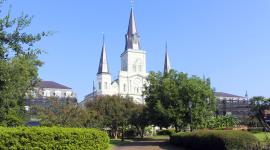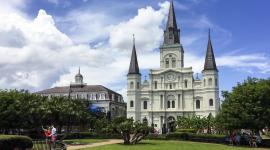Located along the Gentilly Ridge, a topographic remnant of a historic distributary of the Mississippi River, Hebrew Rest takes advantage of the rare high ground in a bowl-shaped city. The cemetery comprises three distinct sections, each occupying a city block on flat ground. The oldest section, Hebrew Rest No. 1, was founded in 1860. Hebrew Rest No. 2 was established in 1894, and No. 3 in 1938. Together, the three sections comprise the largest Jewish cemetery in New Orleans. In 1957, the city’s first Jewish cemetery, Gates of Mercy, was leveled to build a playground, and the remains interred there were moved to Hebrew Rest.
The entry to Hebrew Rest No. 1, along Elysian Fields Avenue, is framed by an ornate cast-iron gate, a relic from the 1884 World’s Fair. A low brick wall with engaged pilasters lines the perimeter of the block, while the other two sections of the cemetery are surrounded by cast-iron fences. All three sections are laid out with graves in a grid-like plan, the first two sections with primary footpaths on cross-axes, and each with trees lining its east-west axis. The tomb markers in each section, however, differ significantly. The tomb markers in No. 1 are characterized by dramatic elevations, often punctuated by tall spires and obelisks embellishing raised-bed tombs. Section No. 2 also contains such ornate memorial architecture, but integrated with shorter, simpler tombstones. Section No. 3, to the north, is notably different, with simple tombstones arranged in rows across the length of a grassy lawn. The cemetery also houses a Modernist mausoleum built in the mid-1960s, which contrasts with the rounded tops of the grave markers and complements the flat topography of the site.


















